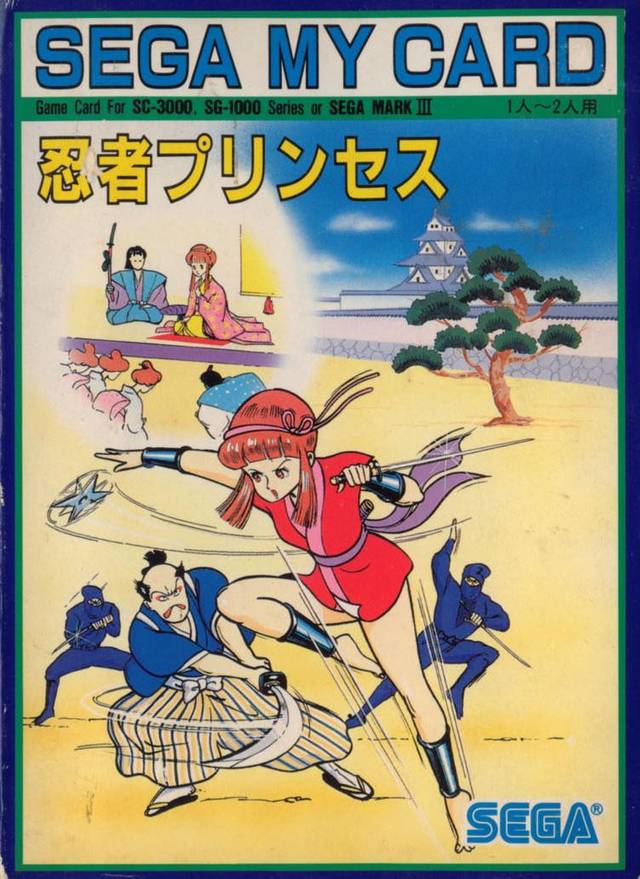
PLAYERS: 1-2 alternating
PUBLISHER/DEVELOPER: Sega
GENRE: Action
RELEASE DATE: 1986 (JP)
“Ninja Princess: feminist warrior raging against the male oppressors or just another chick in drag?”
The answer to such a ridiculous rhetorical question is, of course, neither. The Ninja Princess of the title, Princess Kurumi, is a member of the aristocracy who gets dethroned by one of her trusted advisors. In response to this outrage, she dresses up as a ninja and goes after the traitor to reclaim her castle. I wouldn’t know what it’s like to have an advisor, but I’d certainly be pissed if, say, my cat kicked me out of my house and declared it theirs. Can you imagine the litter?!
Let’s say we were to go all “20XX” analytical on this game made in 1986: Ninja Princess would likely be used as an example of strong females in gaming. Princess Kurumi might have a good cry after her home is taken away, but who wouldn’t? She picks herself up, puts on ninja garb, and goes for it. So yeah, Kurumi is a strong female, but Ninja Princess is not a political statement. Like so many other female character-driven games hyper-analyzed until I couldn’t possibly give a damn, Ninja Princess is just a good game that happens to have a female protagonist, the end.
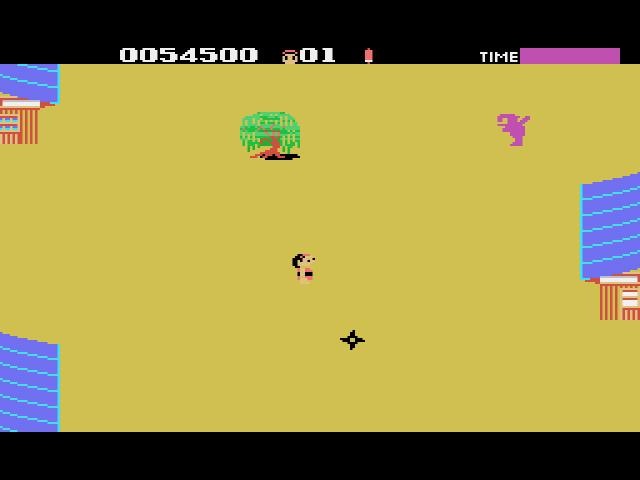
The style of play is top-down horizontally scrolling action, a la Gun.Smoke, Commando, and Ikari Warriors. Since you’re a Ninja Princess (who, by the way, looks nothing like the traditional ninja portrayed in every other game), naturally by mid-80s game logic, your enemies are other ninjas. The enemy ninjas are multi-colored for your convenience: different colors have different attack patterns. Some ninjas jump from rooftops, others imitate rocks, and still others appear ghost-like and chase you down. The ninjas put on a tough front, but if you jam your thumb on the attack buttons and move out of the way of their attacks, your Highness will be fine.
Enemies will occasionally drop scrolls that increase your attack power from standard throwing knife to Omega Shuriken status. The shuriken are broader and can take out several enemies with one hit, so there’s no reason not to upgrade. Button 2 allows you to attack in any direction, while Button 1 is only a forward attack. I’m not sure why you would ever use Button 1 over Button 2, but hey, we can’t all be ninja princesses! Button 1 and Button 2 pressed at the same time will cause Kurumi to disappear in mid-air for a couple seconds. Disappearing can be tricky to pull off, but when executed properly, it will allow you to avoid enemy attacks.
Every level ends with what appears to be a witch boss, who twirls a magical baton around her person in a fast and circular (and possibly satanic) motion. Getting past her requires you to spam your attack as quickly as possible in her face. The witch dies, bonus points are obtained (or not), and Kurumi is one step closer to regaining her castle.
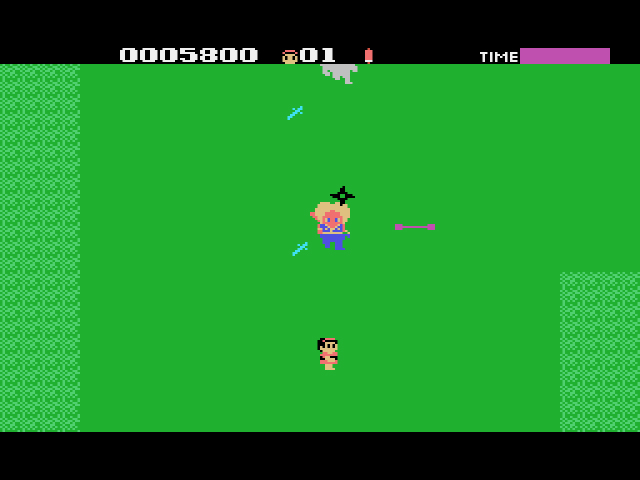
What distinguishes Ninja Princess from more repetitive SG-1000 action games is the variety of level layouts and the strong sense of progression. Before you begin a level, a map of the surrounding area is displayed, showing you how close you are to the castle, and ultimately, the end. As you move further into the game and on the map, the environments shift from forest to village to castle outskirts to the castle wall, and finally, into the castle itself. This might seem like a small point to some, but this dedication to detail immerses you in the game’s story. Compared to previous SG-1000 action games, Ninja Princess‘s twelve (or so) stages feels like an actual journey instead of a meaningless three-stage loop.
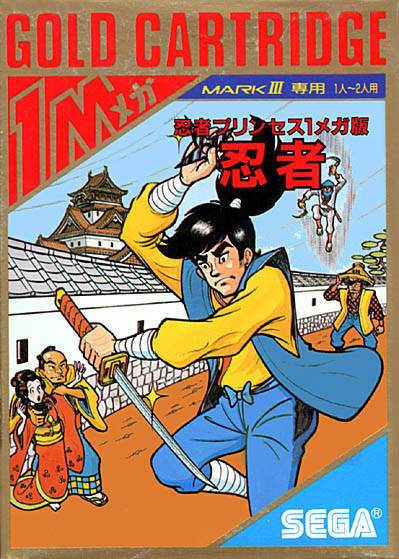
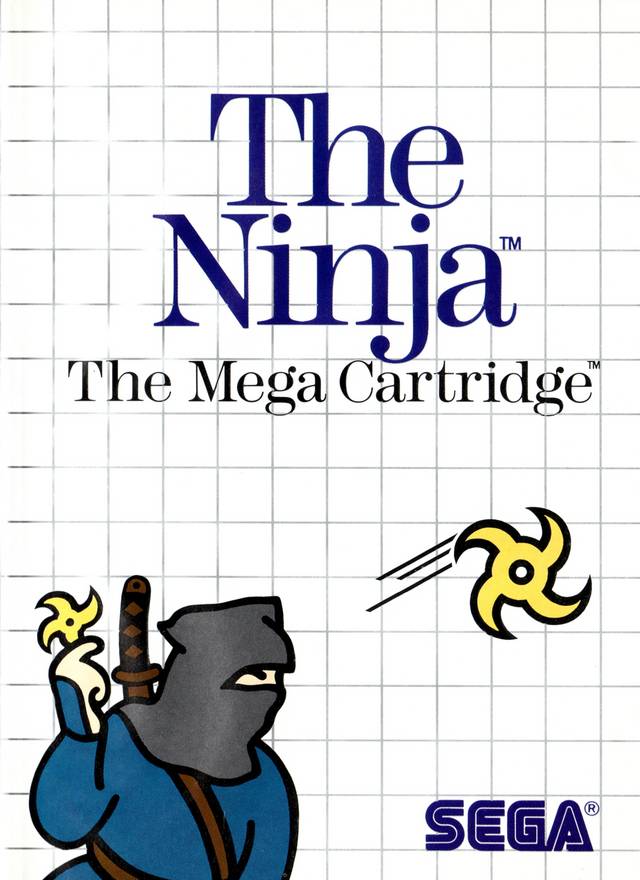
PLAYERS: 1-2 alternating
PUBLISHER/DEVELOPER: Sega
GENRE: Action
RELEASE DATE: 11/08/86 – (JP), 1986 – (US), 11/87 – (EU)
But why would Sega release Ninja Princess for the SG-1000 when they had a perfectly good Mark III in need of some solid games? That’s a fair question, but to answer it, we need to travel back in time by exactly one year. Ninja Princess actually began life in the arcades in 1985. The core gameplay, characters, story, and environments are all the same, save for sharper graphics and a couple arcade-only levels. When Ninja Princess was brought over to U.S. arcades, the game’s name was changed to Sega Ninja, but every other feature of the game was exactly the same including the presence of Princess Kurumi as the protagonist.
Later in 1986, however, Kurumi received a mysterious sex change and reappeared as a male in The Ninja for the Master System. One might think this was just a Western retooling for the States, since the majority of gamers in the U.S. at the time were – supposedly, statistically – young males. But The Ninja saw an ’86 release in Japan as well, despite the presence of Ninja Princess on the SG-1000, and a release in Europe in 1987 where gamers were none the wiser about Sega’s transgender shenanigans.
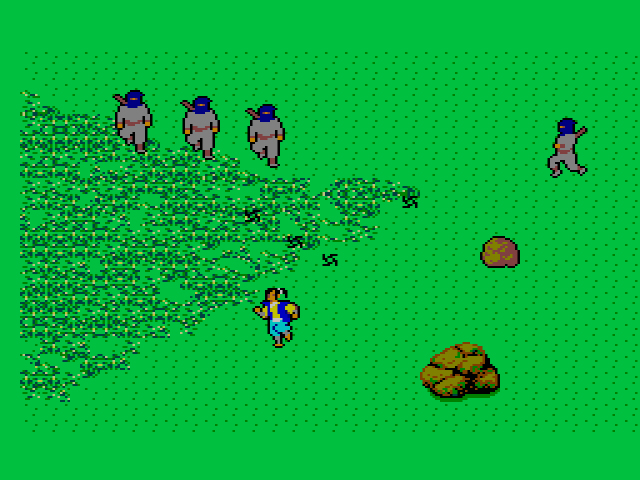
There’s absolutely nothing wrong with The Ninja. It plays exactly like Ninja Princess – top-down action scroller, two attacks, one weapon upgrade, lots of enemy ninjas with scores to settle – but instead of playing as the colorful Princess Kurumi, you play as Kazamaru, a nameless, faceless soul. Now, male characters, female characters, I don’t really care what sex I play as. What I want is personality from my protagonists, and Kazamaru has no discernible personality. As far as I could tell, he’s just another dude rescuing a woman from distress. Now, I don’t care that the man-rescues-woman-and-defeats-all-evil trope is the plot of The Ninja. I just prefer Princess Kurumi’s story of upheaval and reclaiming of a kingdom more.
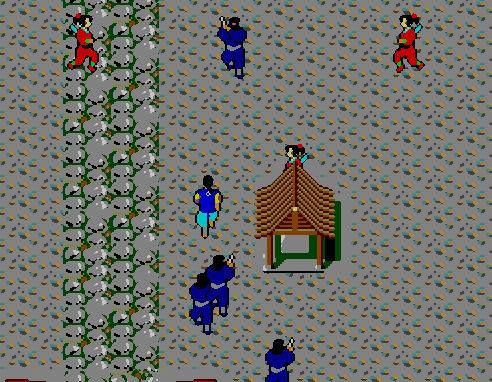
Whereas Ninja Princess feels like Sega crafted it for an all-encompassing audience, The Ninja feels like Sega jumping on the Western action hero bandwagon in order to appeal to… the select few in the States who bought a Master System? A group of macho males that would never play a game with a woman as the main character? I know these types of guys existed then, and they probably exist today. But to think that Sega was so concerned about the sex of the main character that they reworked an entire game just to accommodate for this supposed audience? That’s both admirable and sad.
NINJA PRINCESS: B+
THE NINJA: B-

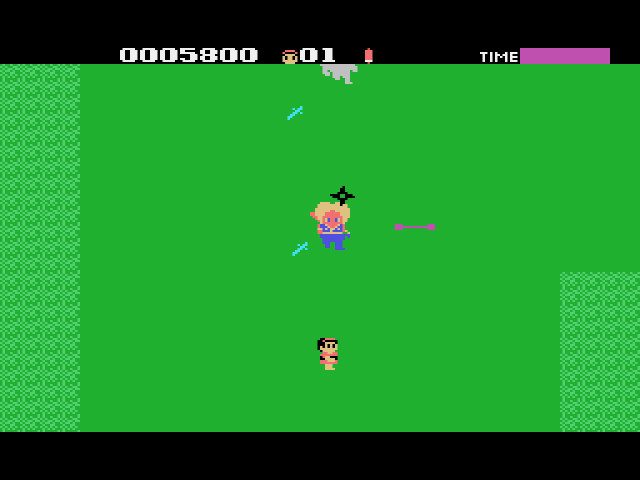
11 replies on “Ninja Princess / The Ninja (SG-1000 / MS, 1986)”
I reread this a couple of times. Basically I agree with most of what is said. But I think your cutting the SMS version a little short. I’ll add a few things.
First of all I absolutely agree. It’s a much more interesting game with the female princess. I originally played this on the SMS, but when I played it in the arcade, I immediately noticed that it was a ninja princess. It was more interesting playing as as a girl although the SMS essentially plays the same as the arcade.
Second the arcade levels missing from the SG-1000 are not bonus levels. They are actually really cool levels that they could probrably not do on the SG-1000. They are full levels that change up the scrolling and gameplay. They are one of my favorite parts of the game. And are fully intact in the SMS version. The first has you running diagonally up a hill fighting ninjas while while large boulders cascade diagonally down the screen you have to dodge. The next in the village area has you fighting across the level fighting in a stampede of horses which was really cool at the time. The third has you fighting Frogger style, a level where you hop across logs on a river while enemies come across on the logs. They did appently keep the levels in the SG-1000 where you scale the castle walls. These levels were awesome on the SMS version and looked better than anything the NES was doing at the time. Also these levels are where your magic attack is indispensable to avoid death when boxed in by environmental threats, like avoiding a boulder, or dogging a star when you are on a small log where you can’t evade.
Also as far as why anyone would use button one. Well you are the first person to review this that has actually said that that I know of. Most reviews talk about the easiest strategy is to use button one to advance until a enemy appears, retreat and center yourself under the enemy and use button one. Most reviewers say that they rarely use button 2. Personally I’m in the middle. I strategically use both attacks. But they key to getting 100 percent scores is to get the shiruken power up and round a whole bunch of enemies upon a line and while running backwards, use button one to take them all out in one shot.
And why get 100 percent? Well the other thing you did t mention, on the SMS version you have to collect the 5 green scrolls to access the last level and beat the game. They are often hidden by shooting a specific rock or tree, or walking in a certain spot. If you reach the end of the first part of the castle you will get sent back to the first level where you missed a scroll. And one of the scrolls requires you to get 100 percent accuracy on the level. Only after you get all five will you go to the second part of the castle and be able to beat the game. It kind of pissed me off at the time because you had to basically shoot and walk around odd places to find the scrolls. I think in a game magazine they gave a guide to find all the scrolls is how I finally beat it.
Also the boss with the red hair is not a witch, but a Samurai type character dressed up in Kabuki makeup.
I’m curious how far you played on the SMS version. To me it is a really great game with a sense of progression across a fuedal Japan landscape. (And I’m assuming shortly after Western contact because the later samurai bosses shoot guns at you.)
Also once again I wish you had a few screenshots of the the great looking boulder or horse levels or the bosses on the SMS version.
Sorry so long but I really love this game. One of the early games that really sold me on the SMS. (Even though initially I had no idea the protagonist was originally a female.)
I will address your points in the order they were given.
“Second the arcade levels missing from the SG-1000 are not bonus levels. They are actually really cool levels that they could probrably not do on the SG-1000. They are full levels that change up the scrolling and gameplay.”
This was my mistake. I did not get this far in the Ninja (which kinda answers your later question). And yes, they did keep the levels in the SG-1000 version where you scale the castle walls. They are difficult, to say the least.
“And why get 100 percent? Well the other thing you did t mention, on the SMS version you have to collect the 5 green scrolls to access the last level and beat the game.”
I read about this, but did not include it in the review for reasons that escape me.
“Also the boss with the red hair is not a witch, but a Samurai type character dressed up in Kabuki makeup.”
Your experience with the game has trumped mine. However, in the SG-1000 version, he/she really looks like an old crone. Thus my words “with what appears to be a witch boss.”
“I’m curious how far you played on the SMS version.”
I didn’t get that far. Third level, maybe? The Master System version felt slow and clunky to me compared to the SG-1000 version (I almost beat Ninja Princess). I should have put the latter point in the review, I suppose.
“Also once again I wish you had a few screenshots of the the great looking boulder or horse levels or the bosses on the SMS version.”
I’m trying to get better about screenshots. There are times when I get caught up in the game and I forget to take shots when I should.
Reviewing games is difficult. Let no one tell you otherwise.
Sorry if I sounded a bit critical I was more trying to share a little extra information. Mostly because I really like this game and spent ally of time playing it in the past. As far as the witch thing. I think I was looking at some arcade flyers at HG 101 where they show the character in more detail and in the arcade game it’s a little more obvious. I would have totally thought witch as well looking at the SG-1000 graphics and it would make sense.
I think it’s baffling as to why they changed the main character. I mean the arcade game was kept intact over here. I’ve played a lot of the arcade as well. I really liked the Ninja Princess storyline. It’s not surprising, but kind of sad they didn’t feel they could keep the original character of the game intact. Also see Alex Kidd in High Tech world which was another game with a princess that got shoehorned into an Alex Kidd game.
I guess really the arcade is the best version of this (can play on MAME) although the SMS version has extra features added to make the game last longer for home play and make it a little more challenging. You know, even being part of that pre teen male gaming group. I would have totally still bought this game with a female character. I think they were underselling their audience.
No, I appreciate you calling me out on facts/points I may have missed. It’s the only way I’ll learn, Sean, and I mean that sincerely.
I agree that the arcade is probably the best version all around. I played it a little bit and it’s a beautiful well-made arcade game. Unfortunately, with a name like “Sega Ninja,” Sega destined the game to obscurity, at least in the US.
I also agree that Sega was underselling their audience. I always played as Chun-Li in Street Fighter II when I was young (still play as her in SFIV, actually), and I always played the female characters in beat-em-ups also. They were faster than the guys, and they hit hard, despite their stats claiming otherwise.
Also is here is a good short 100 percent playthrough (About 9 minutes.) of the SMS game. With all the scrolls and levels.
http://youtu.be/ifDhNz0NeYw
This is why people who are biased politically shouldn’t review games. Giving a game a B minus because of your bias is pretty bad. I like both versions of this game, but will play The Ninja sooner than Ninja Princess simply because I’m used to that port more, same with the SMS versions of Shinobi and Outrun. Remember that The Ninja was made in the 80s so the move to change the sex of the character had little to do with sexism, but marketing. As long as games have strong female characters now, that’s all that should matter.
“Now, male characters, female characters, I don’t really care what sex I play as. What I want is personality from my protagonists, and Kazamaru has no discernible personality. As far as I could tell, he’s just another dude rescuing a woman from distress. Now, I don’t care that the man-rescues-woman-and-defeats-all-evil trope is the plot of The Ninja. I just prefer Princess Kurumi’s story of upheaval and reclaiming of a kingdom more.”
I don’t have a bias. Just wanted you to know.
Also, were I to rewrite this review now, I would remark that Ninja Princess is far easier to control than the Ninja – which makes no sense, given that the SG-1000 controller is a piece of garbage. So really, I just think The Ninja is a lesser port. I’ll edit the review to reflect this in the future.
OK, sorry if I sounded a bit annoyed. Gaming has improved as far as the representation of female characters anyway. The Ninja does hold a special place for me because I played it when I was really little in the 80s and loved it. Classic.
No worries, Jim.
When I decided to start collecting for the Master System again in 2014 The Ninja was one of the first games I got for it. Paid £2.50 for it and I still think it was worth every penny. I love that game. It really has that early Master System charm.
Tony! Glad to hear from you, my friend.
I still can’t get into The Ninja, but I agree, it does have an early Master System vibe going on.